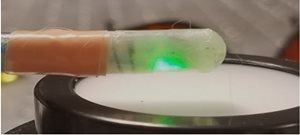Apr 25 2019
A newly built endoscope could offer doctors an improved view of intestinal variations caused by Crohn’s disease. This extra information would help enhance the treatment of the painful and incapacitating form of inflammatory bowel disease, which presently impacts hundreds of thousands of American adults.
 Researchers developed an endoscope that can perform photoacoustic imaging. The new device could give doctors a better view of intestinal changes caused by Crohn’s disease. (Image credit: Guan Xu, University of Michigan)
Researchers developed an endoscope that can perform photoacoustic imaging. The new device could give doctors a better view of intestinal changes caused by Crohn’s disease. (Image credit: Guan Xu, University of Michigan)
Scientists from the University of Michigan illustrate the new device in The Optical Society (OSA) journal Biomedical Optics Express. The endoscope is used for photoacoustic imaging, a comparatively new biomedical imaging technique that uses light to create sound waves in tissue that can be captured using ultrasound imaging.
“This new imaging technology could help more accurately plan therapy for each Crohn’s disease patient,” said Guan Xu, leader of the research team. “This would allow more targeted treatment and help minimize any adverse effects that might result from treatment.”
Making treatment decisions
In Crohn’s disease, both fibrosis and inflammation cause the development of strictures — areas of narrowing — in the intestines. Even though strictures caused by inflammation can be treated with drugs, the ones caused by fibrosis have to be taken out surgically.
Currently, there is no imaging modality that can be used in the intestine to distinguish inflammation from fibrosis. The difficulty in accurately assessing the presence and development of fibrosis in the strictures adds a great deal of complexity to Crohn’s disease management decisions.
Guan Xu, Study Lead, University of Michigan.
In the new research, the scientists built a capsule-shaped photoacoustic imaging endoscope to test whether this imaging method could be used to define fibrosis and inflammation in intestinal strictures. The capsule-shaped probe measured 7 mm in diameter and 19 mm in length.
They engineered the endoscope to supply near infrared light at 1310 nm as this wavelength is absorbed by collagen protein, which is typical of fibrosis. The light absorption makes the protein to expand marginally, causing a mechanical vibration that can be captured with ultrasound imaging. To produce a strong signal, the scientists built the endoscope to maximize supply of 1310-nm light.
Distinguishing inflammation and fibrosis
The new endoscope was tested by the scientists on rabbit models with intestinal narrowing caused by either inflammation only or a mix of inflammation and fibrosis. The experiments revealed the endoscopic photoacoustic imaging method could quantitatively distinguish inflammatory from fibrotic intestinal strictures. Another research on rabbits showed that the endoscope could also quantify the formation of fibrosis over a period.
“The method we demonstrated is minimally invasive and can directly assess fibrosis in the intestinal stricture, which has not been demonstrated by conventional medical imaging modalities,” said Xu.
The scientists are currently involved in making the endoscope sufficiently small to pass through the instrument channel of a colonoscope, a flexible fiber-optic instrument used to analyze the large intestine. This could offer a surgeon with diagnostic information instantly prior to treatment without the necessity for supplementary procedures.